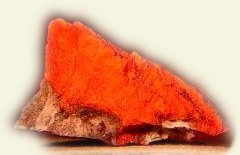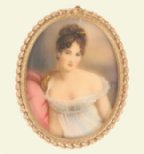November 2009
Member Editorial
Part I Written By CDHM Artisan
Carolyn Kraft

 Miniature means small, right? Wrong! Even though the Latin word for "the smallest" is minimum, the origin of the word miniature comes from the Latin term 'miniare' (to color with red lead). But that doesn't make any sense! What does the Latin word for red have to do with that perfectly carved Queen Anne chair that is only 3½ inches high and sitting in a room the size of a large shoebox? Nothing!
Miniature means small, right? Wrong! Even though the Latin word for "the smallest" is minimum, the origin of the word miniature comes from the Latin term 'miniare' (to color with red lead). But that doesn't make any sense! What does the Latin word for red have to do with that perfectly carved Queen Anne chair that is only 3½ inches high and sitting in a room the size of a large shoebox? Nothing!
Miniature is one of those strange words that does not make sense. The origin of the term "miniature" has nothing to do with size or scale, but rather the materials and technique used in the coloring of medieval manuscripts. In the 13th century, before printing was introduced into Europe, ancient documents and manuscripts were being "illuminated": reproduced with detailed illustrations to convey the story and meaning of the written word to those who could not read. One of the most popular colors, produced from a type of red lead known in Latin as minium, was used to contrast the titles, headings, and elaborate capital letters from the black ink of the text. The art of coloring these letters became known as miniaire, which later became a general term meaning to illuminate a manuscript. The noun form, miniatura, denoted a manuscript illustrated not only in red, but in all colors. These detailed illustrations, or miniature paintings, were cut out of these books or documents so that they could be carried more easily. Later, developing from the form of a carried miniature, portrait miniature artists were commissioned to paint small portraits, the precursors to today's wallet size photographs.
carried more easily. Later, developing from the form of a carried miniature, portrait miniature artists were commissioned to paint small portraits, the precursors to today's wallet size photographs.
In the 16th century the art of miniature painting was introduced to England. Portrait miniatures became widely popular in the 17th and 18th centuries as it was now possible to have a portable version of a loved one. Even arranged marriages were affected: now, a nobleman could send a miniature portrait of his daughter to a potential suitor in another country. Of course, some fathers must have wished this new art form never existed, and some suitors thanked their lucky stars it did. As miniatures became more accessible to the common man, sailors and soldiers could carry a portrait of their loved one while away from home. Miniature portraits were soon being mounted on jewelry and lockets, but with the advent of photography, the popularity of miniature portraits declined.
Although the term miniature was applied to the art form just 700 years ago, miniature art dates back thousands of years to drawings on rocks and ancient Egyptian papyrus manuscripts. These early cultures also told stories through detailed pictures. Even though it could have been on a rock the size of a house, it is still known as miniature art.
years to drawings on rocks and ancient Egyptian papyrus manuscripts. These early cultures also told stories through detailed pictures. Even though it could have been on a rock the size of a house, it is still known as miniature art.
So how in history did red lead paint become an illustrated painting which became a Queen Anne chair in a shoebox? Because a book is small in comparison to a canvas or a wall, and the word miniature, borrowed into English from the Italian miniatura, came to mean not only a manuscript illustration, but any small portrait or painting. Eventually, the meaning was extended to include anything small, be it a portrait or a plate. Enter the passion we know and love today. Was it coincidence that the miniatures of then and now both require a meticulous approach to detail and a great deal of patience on the part of the artist? It must have been karma. If history had followed proper definitions, we would be known today as minimalists, and that really doesn't make sense!
PART II of our series, "The History of Miniatures: Miniatures Go Three Dimensional" - Next Month!
CDHM Artisan
CDHM Artisan, Carolyn Kraft
Custom Dolls, Houses & Miniatures / CDHM




